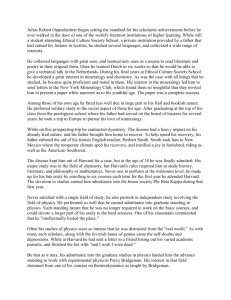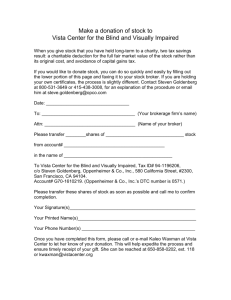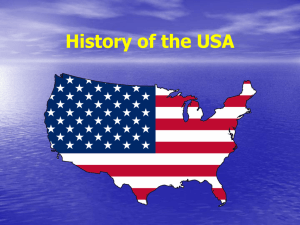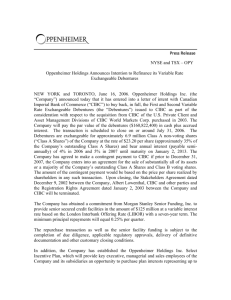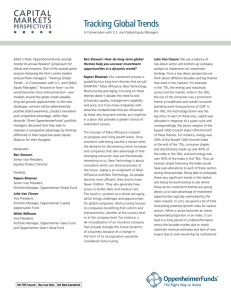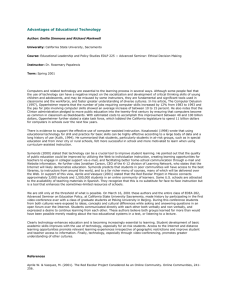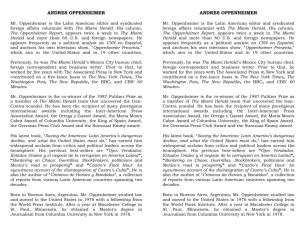Notes Chapter 4 - Brotherhood of the Bomb
advertisement
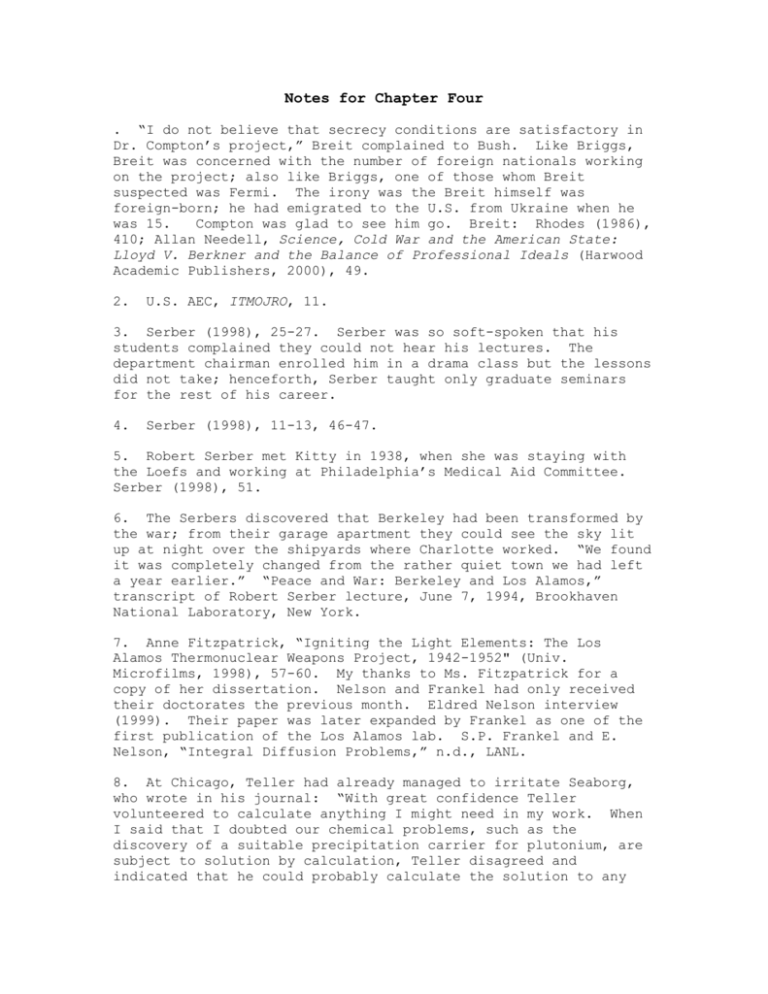
Notes for Chapter Four . “I do not believe that secrecy conditions are satisfactory in Dr. Compton’s project,” Breit complained to Bush. Like Briggs, Breit was concerned with the number of foreign nationals working on the project; also like Briggs, one of those whom Breit suspected was Fermi. The irony was the Breit himself was foreign-born; he had emigrated to the U.S. from Ukraine when he was 15. Compton was glad to see him go. Breit: Rhodes (1986), 410; Allan Needell, Science, Cold War and the American State: Lloyd V. Berkner and the Balance of Professional Ideals (Harwood Academic Publishers, 2000), 49. 2. U.S. AEC, ITMOJRO, 11. 3. Serber (1998), 25-27. Serber was so soft-spoken that his students complained they could not hear his lectures. The department chairman enrolled him in a drama class but the lessons did not take; henceforth, Serber taught only graduate seminars for the rest of his career. 4. Serber (1998), 11-13, 46-47. 5. Robert Serber met Kitty in 1938, when she was staying with the Loefs and working at Philadelphia’s Medical Aid Committee. Serber (1998), 51. 6. The Serbers discovered that Berkeley had been transformed by the war; from their garage apartment they could see the sky lit up at night over the shipyards where Charlotte worked. “We found it was completely changed from the rather quiet town we had left a year earlier.” “Peace and War: Berkeley and Los Alamos,” transcript of Robert Serber lecture, June 7, 1994, Brookhaven National Laboratory, New York. 7. Anne Fitzpatrick, “Igniting the Light Elements: The Los Alamos Thermonuclear Weapons Project, 1942-1952" (Univ. Microfilms, 1998), 57-60. My thanks to Ms. Fitzpatrick for a copy of her dissertation. Nelson and Frankel had only received their doctorates the previous month. Eldred Nelson interview (1999). Their paper was later expanded by Frankel as one of the first publication of the Los Alamos lab. S.P. Frankel and E. Nelson, “Integral Diffusion Problems,” n.d., LANL. 8. At Chicago, Teller had already managed to irritate Seaborg, who wrote in his journal: “With great confidence Teller volunteered to calculate anything I might need in my work. When I said that I doubted our chemical problems, such as the discovery of a suitable precipitation carrier for plutonium, are subject to solution by calculation, Teller disagreed and indicated that he could probably calculate the solution to any chemical problem that I might pose to him.” 73. Seaborg (1992), I, 9. Bethe believed that Teller’s personality underwent a change in 1932, when Edward was humiliated by physicist George Placzek while studying in Rome: “Placzek treated Teller very roughly. He made fun of him.” Bethe interview (1988). 0. Bethe: Schweber (2000, 76-104; Rhodes (1986), 188-90; Blumberg and Owens, 108. 1. Blumberg and Owens, 75-76. 2. Teller to Fermi, July 17, 1942, “Enrico Fermi, 7/17/425/17/44" folder, box 74-17, LANL. 3. Oppenheimer picked the restaurant because Van Vleck was a train buff. Berkeley seminar: Fitzpatrick, “Igniting the Light Elements,” 58; Eldred Nelson interview (1999). 4. Serber (1998), 68-69; Eldred Nelson interview (1999). 5. Bethe’s theories of how the stars produced their energy would win him a Nobel prize the following year. 6. Bethe claimed that he and Teller worked together to restrain Serber, “who was trying to make things too complicated.” Bethe interview (1988). 7. Robert Serber interview (1992). 8. Oppenheimer evidently left in such a hurry that the exact purpose of his mission remained unclear to those he left behind. Bethe thought it was to alert Compton to the prospects of a weapon far more destructive than the atomic bomb that could be built with greater ease and at less cost. Teller believed it was to warn Compton that the group at Berkeley had accidentally stumbled across a path of research that might be literally world ending, if taken to its conclusion. Possibly it was both; each fit the description of “very disturbing news” that Oppenheimer had hurriedly and cryptically given Compton over the phone. 9. “Better to accept the slavery of the Nazis than to run a chance of drawing the final curtain down on mankind!,” was how Compton remembered their thinking in his memoirs. Arthur Compton, Atomic Quest (Oxford Univ. Press, 1956), 128. 20. Hewlett and Anderson, 102. 2. Oppenheimer may have exaggerated his colleagues’ misgivings. Serber subsequently described the seminar as “very lively” and even “a lot of fun.” Serber (1992), xxxi. 22. Teller had not overlooked the inverse Compton effect, but believed that it occurred too slowly to have an impact upon the reaction. Bethe claimed that he proved otherwise. Bethe interview. 23. Hewlett and Anderson, 104, 675 fn.; U.S. AEC, ITMOJRO, 11; Rhodes (1986), 420-21. 24. Rhodes (1986), 421. 25. Oppenheimer evidently belonged to the ranks of the doubters. Responding in September to a letter from Teller, who had proposed some new ideas for the Super, Oppenheimer wrote that “the suggestions that you make have by now for us a pretty fantastic sound.” Vincent Jones (1985), 58-59. 26. “...the W[ar] D[epartment] has turned thumbs down on O[ppenheimer] by telephone,” Compton’s secretary informed him. Memorandum of conversation, Aug. 18, 1942, box 1, JRO/AEC. 27. The Investigations Division of the Army’s Western Defense Command at San Francisco’s Presidio had denied Oppenheimer’s clearance on the grounds that Oppie’s admitted membership in two organizations thought to be led by Communists and a third suspected of Communist leanings made him a security risk. However, the Provost Marshall’s office reinstated the clearance based upon letters from Oppenheimer’s associates at Berkeley, who described him “as a man of high character and integrity and thoroughly loyal.” Oppenheimer clearance: “Subject: Oppenheimer, J. Robert,” various documents, box 1, JRO/AEC records; “The Counter Intelligence Corps with Special Projects,” vol. VIII, 62, History of the Counter Intelligence Corps (U.S. Army Intelligence Center, Fort Holabird, Maryland, n.d.), Modern Military Records, National Archives. 28. Oppenheimer to Conant, Oct. 12, 1942, #140, Bush-Conant file, OSRD/NARA. Lawrence said that A.C. Klein, chief engineer for Stone and Webster, must have learned about the Super from Oppenheimer during a train trip east; Oppie had apparently tried to impress upon Klein the need for quick action on the heavy water facility in British Columbia. Wensel to Lawrence, Sept. 1, 1942, and Lawrence to Wensel, Sept. 9, 1942, #140, Bush-Conant file, OSRD/NARA. 29. Oppenheimer to Conant, Oct. 12, 1942, #140, Bush-Conant file, OSRD/NARA. 30. For security reasons, the bomb project was initially disguised under the acronym “DSM Project,” for Development of Substitute Materials. “Report of S-1 Meeting,” June 25, 1942, #120, Bush-Conant file, OSRD/NARA. 3. Lawrence suggested charging the quarter-million-dollar cost of the land against the overhead for the S-1 project, but Sproul refused. Aug. 15, 1942, Memos, box 39, Sproul papers. 32. Harold Fidler, Jan. 14, 1997, personal communication. 33. “Minutes of Fifth Meeting,” Sept. 13-14, 1942, #117, BushConant file, OSRD/NARA; Leslie Groves, Now It Can Be Told: The Story of the Manhattan Project (Harper, 1962), 18. 34. Heilbron, Seidel, and Wheaton (1989), 32; Hewlett and Anderson, 141-44. 35. Childs (1968), 379, 383-84. 36. “Report on Multiple Mass Spectrograph,” Sept. 13, 1942, folder 4, carton 29, EOL; Childs (1968), 336. 37. Smyth (1989), 82-83; Groves (1962), 3-4. 38. Nichols would have the title of district engineer for the Manhattan Project. K.D. Nichols, The Road to Trinity: A Personal Account of How America’s Nuclear Policies Were Made (Morrow, 1987), 42-43. 39. Groves (1962), 22. 40. Transcript of interview with Vannevar Bush, Reel 7, 422, Vannevar Bush papers, MIT. 4. Lansdale interview; “John Lansdale, Jr.: Military Service,” 23-24. 42. Stimson and Bush appointed the committee to represent the two services and the OSRD. Somervell’s chief of staff, Brigadier General Wilhelm Styer, served for the Army; Admiral William Purnell represented the Navy. Stimson made Bush chair of the committee, with Conant acting as his deputy. Bush had originally proposed a nine-member committee, but Groves insisted upon a smaller group for greater efficiency. Hewlett and Anderson, 83. 43. Afterward, Groves had lunch with Lawrence, Oppenheimer, and Sproul at the president’s house. Visiting from Chicago two days earlier, Seaborg had been given the same tour and described the sights in his diary: “Here I saw the 184-inch cyclotron magnet with its two giant calutron tanks. One of the calutrons was in operation; peering through a large porthole, I saw the spectacular blue glow of a beam that carried U238 into one receiver and the rare U235 into another.” Seaborg (1992), I, 279. 44. Serber was amazed to see Groves unbutton his tunic, hand it to Nichols, and order the colonel to get it dry cleaned. Serber (1992), xxxii. 45. A week earlier, in Chicago, Oppenheimer had made the same case to Compton and the Met Lab’s technical council. Oppie argued for “a central laboratory devoted wholly to this purpose, where people could talk freely with each other, where theoretical ideas and experimental findings could affect each other.” U.S. AEC, ITMOJRO, 12. 46. In his memoirs, Groves would claim that he decided Lawrence could not be spared from the electromagnetic separation work. He told others at this time, however, that he shared Bush’s fear–namely, that Ernest would be unable to keep a secret. Groves (1962), 61-62; U.S. AEC, ITMOJRO, 166. 47. Davis, 146. In a 1972 interview, McMillan claimed that when he saw Lawrence in Chicago that September, Ernest had promised, “Well, we will have you for director.” But McMillan said he never took Lawrence’s promise seriously and so was not disappointed when he failed to get the job. Transcript of interview with Edwin McMillan, 207, Bancroft Library. 48. Badash et. al., 13. 49. Oppie would be “extremely difficult to replace, if not impossible,” Birge told the agent. “Report of Special Agent Robert Stepp,” Sept. 20, 1942, box 1, JRO/AEC. 50. Alvarez (1987), 78. 51. Groves (1962), 61 52. Compton (1956), 130; Childs (1968), 337. 53. Goodchild, 66. 54. San Francisco field report, Feb. 10, 1943, file, box 1, JRO/AEC. 55. Oppenheimer to Bethe, Oct. 19, 1942, box 20, JRO. 56. Oppenheimer to Groves, Nov. 9, 1942, entry 5, file 333, MED/NARA. 57. Teller wrote Oppenheimer that he had informed Bethe “we were not very eager to have Alvarez and recommended some caution.” Teller to Oppenheimer, March 6, 1943, Teller file, LANL. From Boston, Rabi wrote Oppie: “it appears that Luis is out of the picture, since his projects here have been raised ten pegs in his own estimation.” JRO. Rabi to Oppenheimer, March 8, 1943, box 59, 58. Telegram, Oppenheimer to Dudley, Nov. 10, 1942, folder 29, carton 8, EOL. Sparsely-populated Oak City, Utah, had been the first place the Army considered as a site for the lab. But since it would have meant displacing some 30 Mormon families, the idea was abandoned. 59. Badash et. al., 1-20; Hewlett and Anderson, 229. 60. Badash et. a., 13-20. 6. Vincent Jones (1985), 85. A senior at the school, Sterling Colgate, recognized Oppenheimer and Lawrence from their pictures in his physics textbook, although the two men used aliases when they visited the school. Colgate found it amusing that Oppenheimer seemed at home with the ruse, while Lawrence visibly flinched upon being introduced as “Mr. Smith.” Transcript, “The Day after Trinity,” Chevalier papers. 62. Although there had been a tacit understanding that Oppie would not raid the government’s other defense projects to staff the desert lab, Conant and Bush relented. Conant to Bush, Nov. 20, 1942, #140, Bush-Conant file, OSRD/NARA. 63. Oppenheimer’s medical history: Memo to record, Jan. 15, 1943, box 100, series 8, MED/NARA; Harold Fidler, Jan. 14, 1997, personal communication. 64. Smith and Weiner (eds.), 247. 65. Even so, Rabi turned down Oppie’s offer to make him associate director at the lab. While the atomic bomb project, if successful, might ultimately win the war, Rabi argued, the failure of the radar work at MIT could lose it. Rabi, moreover, was troubled that a weapon of such destructive power would be “the culmination of three centuries of physics.” Oppenheimer responded: “To me it is primarily the development in time of war of a military weapon of some consequence. I do not think that the Nazis allow us the option of carrying out that development.” Oppenheimer to Rabi, box 59, JRO. Bacher agreed to join the lab but promised to quit the day that the Army took it over. 66. Hewlett and Anderson, 237. 67. Lillian Hoddeson et. al., Critical Assembly: A Technical History of Los Alamos during the Oppenheimer Years, 1943-1945 (Cambridge Univ. Press, 1993), 57-58; Badash et. al., 21-40. 68. Initially, Oppie thought that perhaps a hundred scientists might work at the lab. By early March, however, he was willing to concede the need for more personnel--including a woman to run the nursery, a buyer for the cooperative store, and “a man or woman to assist in establishing the families at the site.” Oppenheimer to Robert Underhill, March 8, 1943, folder 1, box 14, Robert Underhill papers, LANL. When Manley pointed out that they had forgotten to hire shipping clerks, Oppenheimer responded that the only thing to be shipped out of Los Alamos would be the bomb. Davis, 163. 69. Smith and Weiner (eds.), 243. 70. Childs (1968), 351 7. Underhill: Transcript of “Robert Underhill: Contract Negotiations for the University of California,” box 2, Underhill papers, Bancroft Library; “Transcript of Robert Underhill Memoirs,” Underhill papers, LANL. 72. “Transcript of Robert Underhill Memoirs,” Underhill papers, LANL. 73. Underhill pointed out to Sproul that the University of California lacked legal authority to operate in New Mexico. Transcript of “Robert Underhill: Contract Negotiations for the University of California,” 18, Underhill papers, Bancroft Library. 74. Stimson’s letter revealed only that the work was “one of the foundation stones of an extremely important, probably the most important, development project in our war activities.” Vincent Jones (1985), 126. The University’s business manager, William Norton, was miffed when told that the Regents could not visit the mysterious laboratory. Norton to Groves, Jan. 14, 1943, Organization and Administration file, MED History, U.S. Army Chief of Staff records (Army/NARA), Record Group 319, National Archives. 75. Sproul to Conant, Jan. 26, 1943, #96, Bush-Conant file, OSRD/NARA. 76. Irwin Stewart to Underhill, Jan. 23, 1943, and Sproul to Underhill, Feb. 10, 1943, folder 1, box 14, Underhill papers, LANL. At his meeting with Groves, Underhill suggested Caltech, the University of New Mexico, and Chicago as alternative contractors. Shortly afterward, Underhill chanced to run into Oppie outside Grand Central Terminal: “Oppenheimer then told me with great regret they had come to the conclusion that they would have to take the University of California.” Transcript of interview with Robert Underhill, box 2, Underhill papers, Bancroft Library. 77. The relationship got off to a rocky start. On February 13, Groves arrived at Underhill’s office two hours late, accompanied by the man whom Oppenheimer had personally chosen to be the business manager at Los Alamos. Underhill promptly announced that he would pick his own business manager and left to attend a family wedding. The following day, Underhill and other University officials unanimously advised Sproul against signing any long-term contract with the Army, since it appeared “that the University was to be more or less in the position of banker and officially little more.” Sproul asked Underhill to persevere nonetheless. At their next meeting, in Groves’ office at New York’s Biltmore hotel a week later, the general told Underhill three times to sit in a particular chair, so Underhill made a point of crossing the room to sit on a sofa. The deal was informally sealed on February 22, 1943. A separate contract was negotiated for Lawrence’s Calutrons. Underhill to Stewart, March 15, 1945, folder 4, box 13, Underhill papers, LANL. 78. The crisis lasted less than a month. Further calculations showed that spontaneous fission was not a problem with Chicago’s plutonium-producing pile. But Compton used the incident to protest that “compartmentalization”–-Groves’s notorious need-toknow security rule-–was responsible for keeping such potential problems in the shadows for so long. Hewlett and Anderson, 109. 79. “...it will be clear to Mr. Greenewalt and company that the cyclotron method is no cinch and involves very considerable expenditures of materials and equipment as well as personnel,” Lawrence confided to Conant on the eve of the visit. His own preference, Lawrence wrote, was to “push both programs [atomic pile and Calutron] to the maximum and hope for the best.” Lawrence to Conant, Nov. 23, 1942, file 201c, series 5, MED/NARA. 80. Victor Bergeron, Frankly Speaking: Trader Vic’s Own Story (Doubleday, 1973); Harold Fidler, May 28, 1997, personal communication. 8. The Dupont engineer was, nonetheless, impressed by Lawrence: “He could have made any salary that he chose to name as a salesman.” Transcript of interview with Crawford Greenewalt, Hagley Museum, Wilmington, Del. The author thanks Professor David Hounshell for a copy of the Greenewalt interview. 82. The Calutron pilot plant that the Lewis committee recommended building would produce a total of 100 grams of bombgrade uranium for experiments, rather than the 100-grams-a-day plant that Lawrence proposed. Vincent Jones (1985), 104-105. 83. Lawrence persuaded Sproul to spend an additional $50,000 to make the building a permanent structure. It is now Ralph Minor Hall, part of the Optometry Department. Reynolds, n.d., Bancroft Library. Interview with Wallace 84. Minutes of Coordinating Committee, Dec. 23, 1942, book 1, box 27, Lawrence Berkeley Laboratory archives (LBL), U.C. Berkeley. 85. Vincent Jones (1985), 130; Smyth (1989), 201. Reynolds was formerly the University engineer. He had performed a safety installation of the 27-inch cyclotron at LeConte in 1931 and was amazed that no one had yet been killed. Transcript of Reynolds interview, Bancroft Library. 86. Steve Nelson et. al., 269. 87. Serber (1998), 73. 88. Chevalier (1965), 49. 89. Chevalier (1965), 48. 90. Chevalier (1965), 50. 9. Chevalier (1965), 46. In his unpublished memoir, Chevalier wrote: “In the spring of 1942, Oppenheimer was called to Chicago– -it was the first time, I believe, that an absence of his would coincide with a planned meeting of our ‘closed unit’–-to discuss the state of work on the projected bomb.” Typescript of “The Bomb,” 43, Chevalier papers. 92. Jacques–-nicknamed “Snipe”--was following his father’s star. Haakon had recently received a letter from the dean, warning that the son was spending too much time on campus promoting radical causes. Jacques faced expulsion and the draft unless his grades improved. Yet the admonitory letter that Haakon sent to “Snipe” said perhaps more about the father than the son: “There is nothing more pitiful than a left-wing campus intellectual who can’t make the grade. He carries no authority and inspires nothing but contempt.” Haakon Chevalier to “Snipe,” March 6, 1943, and Feb. 28, 1943, “Snipe’s Diary–1935,” Chevalier papers.

